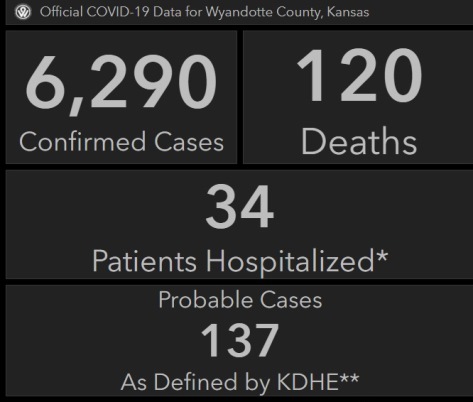
Doctors are urging people to get flu shots this year, usually around October or when the shots become available.
If patients have COVID-19 or similar symptoms and have been isolated, they would want to wait at least 10 to 14 days or later since the start of the symptoms to get a flu shot, according to Dr. Dana Hawkinson, medical director of infection prevention and control at the University of Kansas Health System.
“If you are still suffering from a fever, it wouldn’t be a good time to get a flu shot,” said Amanda Gartner, RN, director of quality and safety at the University of Kansas Health System.
Sometimes people get mild symptoms of flu after a flu shot, and may have muscle aches, fatigue and a fever, she said.
The first 24 to 48 hours after a flu shot would be an anticipated symptom following the vaccine and not a reason to suspect you have COVID-19, she said, and so people should probably monitor it 24 to 48 hours.
Dr. Steve Stites, chief medical officer of the KU Health System, said he thinks the number of flu cases will be lower this year. He said he based his prediction on an Australian study that showed the number of flu cases declined there because of mask-wearing this year.
“We know that the mask culture here in the United States, depending on what community you live in, is a little different from others,” Dr. Hawkinson said.
The steps to mitigate the risk of COVID-19 have decreased influenza cases in other countries, he said. Masks have made a difference, and also there might have been a decrease in the number of people wanting to seek treatment, he said.
“As we can continue to endorse our message of masking, not meeting in large groups, physical distancing, that will also help decrease the spread of influenza as well,” Dr. Hawkinson said.
The doctors answered questions at their video news conference on Friday morning.
They were asked if a person who attended a sporting event with hundreds or thousands of people in attendance should quarantine.
Gartner said the Kansas Department of Health and Environment has mandatory advice if people attended a large venue.
The KDHE travel quarantine list says that those who have attended a mass gathering event out-of-state of 500 people or more, where individuals do not socially distance and wear masks, should quarantine for 14 days after they have arrived back in Kansas.
If they were able to socially distance and wear masks, they would not have to quarantine.
The doctors noted there wasn’t as much mask-wearing in the stands at the Chiefs game in the fourth quarter on Thursday night as there was at the start of the game.
The University of Kansas Health System reported 22 acute COVID-19 patients in the hospital on Friday morning, with four in the intensive care unit and two on the ventilator, according to Dr. Hawkinson. There were five patients on the ventilator who are considered to be in COVID-19 recovery status, he said, and 29 to 30 patients in active recovery status.
Wyandotte County reported an increase of 44 COVID-19 cases on Friday afternoon, for a cumulative total of 6,290, according to the Unified Government COVID-19 webpage. There was one additional death, for a cumulative 120.
On Friday, the Kansas Department of Health and Environment reported that Johnson County had the highest number of COVID-19 cases in the state, with a cumulative 9,350. It was an increase of 203 cases since Wednesday.
According to KDHE information, some of the other counties with high numbers of cases, besides Johnson and Wyandotte, included Sedgwick, 7,839; Ford, 2,486; Shawnee, 2,448; Finney, 1,835; Leavenworth, 1,819; Douglas, 1,709; Seward, 1,356; Riley, 1,120; Lyon, 911; Reno, 893; Crawford, 855; Butler, 712; Ellis, 685; and Saline, 525.
The KC Region COVID-19 Resource Hub reported 36,747 total cumulative cases in the nine-county region.
The KU doctors’ news conference is at https://www.facebook.com/kuhospital/videos/314483242962749
The UG COVID-19 webpage is at https://alpha.wycokck.org/Coronavirus-COVID-19-Information.
The KDHE active cluster list is at https://www.coronavirus.kdheks.gov/160/COVID-19-in-Kansas.
The Unified Government COVID-19 hub outbreak map is at https://wyandotte-county-covid-19-hub-unifiedgov.hub.arcgis.com/.
To see an NEA list of schools that have had COVID-19 cases, visit https://app.smartsheet.com/b/publish?EQBCT=aa3f2ede7cb2415db943fdaf45866d2f
The KC Region COVID-19 Hub dashboard is at https://marc2.org/covidhub/.
The Unified Government Health Department is collecting input on people’s experiences getting tested for COVID-19 in Wyandotte County. The survey is on the UG website at https://us.openforms.com/Form/ea97a450-3d74-4d86-8d1f-6e340d55cf7c.
The UG Health Department new school and sports guidance is online at https://alpha.wycokck.org/files/assets/public/health/documents/covid/09042020fallsportsrecommendations.pdf.
A previous UG sports order is online at https://alpha.wycokck.org/files/assets/public/health/documents/covid/08132020localhealthofficerorderregardingsports.pdf.
The Wyandotte County school start order is online at https://alpha.wycokck.org/Coronavirus-COVID-19-Information.
Wyandotte County is under a mandatory mask order and is in Phase 3 of the state’s reopening plan. For more information, residents may visit the UG COVID-19 website at https://alpha.wycokck.org/Coronavirus-COVID-19-Information or call 311 for more information.
The KDHE’s COVID-19 webpage is at https://www.coronavirus.kdheks.gov/.
The CDC’s COVID-19 webpage is at https://www.cdc.gov/coronavirus/2019-nCoV/index.html.
